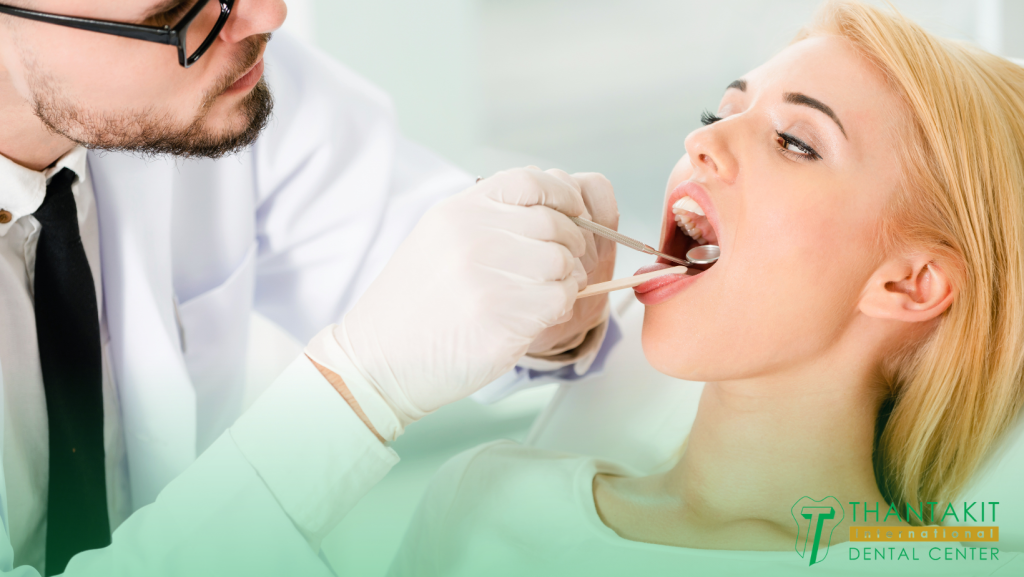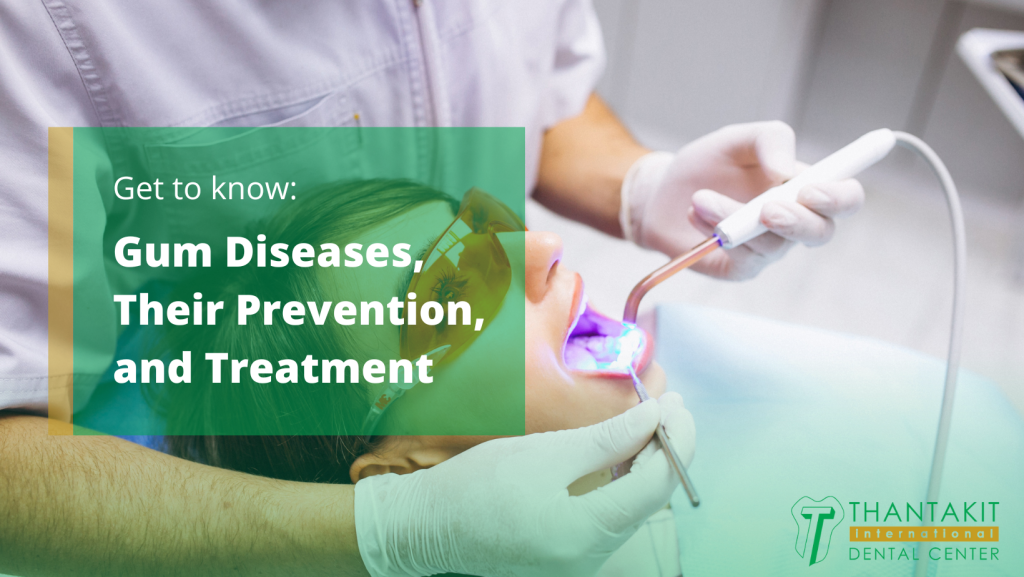Gum disease happens when you have too much plaque, tartar, and bacteria inside your mouth and on your teeth due to you neglecting to observe proper dental hygiene on top of consuming loads of starchy and sweet foods.
Plaque and tartar don’t only affect your teeth, leading to tooth decay from acidic bacterial waste products. The bacterial spread can also affect your gums or gingiva surrounding the teeth, causing inflammation around the tooth.
When worse comes to worst, this could even lead to outright periodontal disease that loosen the teeth’s anchor unto your mouth and jaws.
Page Contents
What are Gum Diseases?
Gum disease happens when your gums bleed and get inflamed due to tartar and plaque formation from rising oral bacterial populations because you don’t brush your teeth often enough.
-
Plaque and Tartar: When bacteria stay on the teeth surface long enough, they form a film known as plaque, which then hardens into calculus or tartar that requires a good scraping from your dentist to remove.
-
When Do They Occur? Things like gingivitis occur as a result of gum inflammation and bacterial infection of the gums. It could even affect the bone surrounding and supporting the tooth that your gums are also wrapped around.
-
Gingivitis Is the Earliest Stage of Gum Disease: The earliest stage of gum disease is gingivitis. It’s when your gums get red, swollen, and prone to bleeding. Its more serious form is known as periodontitis.
-
Periodontitis is an Advanced Stage of Gum Disease: Periodontitis or periodontal disease is when the gums pull away from your teeth while bone tissue is lost, leading to your teeth loosening up to the point of falling out.
-
Periodontal Disease is an Adult Disease: Periodontal disease is a disease mostly associated with adults instead of children. Tooth decay and periodontal disease serve as the two biggest threats to a person’s dental health when push comes to shove.
How Prevalent are Gum Diseases?

Gum diseases are pretty prevalent because all it takes is oral bacteria infecting the surroundings of the tooth, causing gum inflammation around the tooth that could worsen to periodontal disease.
According to a report by the Centers for Disease Control and Prevention (CDC), gingivitis and periodontitis is prevalent in the U.S. by this much:
-
Almost Half of Adults: Adults aged 30 years and older have about 47.2 percent or almost half of them suffering from some form of gum or periodontal disease.
-
Almost a Third of Senior Citizens: As you age, your risk for periodontal disease increases. For instance, 70.1 percent of adults aged 65 years old and older suffer from periodontal disease.
-
More Common in Men Than Women: Only 38.4 percent women suffer from periodontal disease compared to 56.4 percent of men.
-
Poor People, High School Education, and Smokers: 65.4 percent of those living below the federal poverty level suffer from periodontal disease. 66.9 percent of people with less than a high school education suffer from periodontal disease. 64.2 percent of smokers suffer from periodontal disease.
Periodontal disease happens due to gum disease. To be more specific, the more chronic your gingivitis or gum inflammation is due to tartar buildup spreading below your gum line, the likelier it is to progress to periodontitis.
Tartar that has spread below the gum line makes it harder to clean the teeth. You’ll need a dentist or dental specialist to remove calculus and stop your periodontal disease from progressing.
What’s the Difference Between Gingivitis and Periodontitis?
Not all gingivitis worsens towards periodontitis. Most people get gingivitis at some point of their lifetime and only suffer from mild symptoms. It’s pretty easy to treat but also to ignore. Not treating it and neglecting gingivitis is a huge mistake though.
-
What is Gingivitis? Gum inflammation is also known as gingivitis. It’s what happens when you leave plaque and tartar alone by neglecting brushing, flossing, and rinsing your mouth with mouthwash.
-
Symptoms of Gingivitis: Gingivitis in its early stages roots from plaque buildup that causes the gums to swell and easily bleed when you brush your teeth. Even with irritated gums, the teeth remain planted unto your sockets.
-
What is Periodontitis? Periodontitis or periodontal disease is another level of gum disease that stems from chronic gingivitis. It’s a worse kind of gingivitis that extends towards your periodontal ligaments and surrounding bone tissues as your gums recede from your decaying teeth.
-
Symptoms of Periodontitis: Gingivitis is mild periodontitis wherein no irreversible bone or tissue damage has occurred yet. As the plaque gunk releases more acids, it doesn’t only eat at your teeth enamel. Its hardened form, tartar, also forms along the gum line and causes irreversible damage to bone, gum, and tissue.
-
How Plaque Turns to Tartar: Uncleaned bacteria feeding unto your leftover starch and sugar will form plaque, which releases irritating acids that can make your teeth lose minerals. After 72 hours or 3 days, this plaque hardens to tartar that’s harder to clean from along the gum line.
-
Neglect Worsens the Disease: If you leave gum inflammation untreated, thinking it’d resolve itself over time, it can turn into bigger oral health problems down the line like letting a cavity become bigger without getting it filled in.
-
It’s Reversible: Gingivitis is reversible by simply brushing your teeth, flossing, and gargling mouthwash. Also make sure to attend regular dental checkups and cleanings. It gets more expensive as your gingivitis worsens to periodontitis.
How to Prevent Gum Disease Development

Good oral hygiene is your best bet in avoiding gum diseases like gingivitis and periodontitis. Make it a habit to brush your teeth, consistently clean your mouth, teeth, gums, and tongue free of (most) bacteria throughout your entire life.
-
Good Oral Hygiene: Don’t neglect to brush your teeth for two minutes at least twice daily. You can go after every meal including breakfast or three times a day but at least once at daytime and once at nighttime will suffice.
-
The Importance of Flossing: Aside from brushing after breakfast and before going to bed, you should also floss at least once daily. Actually, floss before you brush to clean away hidden food particles and bacteria while letting brushing clean away the rest.
-
Mouthwash: Don’t believe the old wives’ tale of limiting your gargling of mouthwash because you don’t want to kill all the bacteria in your mouth. Gargle with products like Listerine or Betadine as instructed by your dentist or according to what the label recommends.
-
Preventive Maintenance 101: Good oral hygiene exists to prevent bacterial overpopulation, plaque formation, acidic waste products, and tooth decay as well as periodontal or gum disease.
-
Regular Dentist Visits: Regular visits to your dentist, dental hygienist, or periodontist will allow for regular checkups of your oral health. The hygienist or dentist can regularly do teeth cleanings or prophylaxis treatments for you every 6-12 months.
-
Clean More Often If You Have Risk Factors: If you have risk factors that raise your risk for periodontal disease development such as smoking, taking certain medicine, or cotton mouth, you may need to have your mouth cleaned more often than twice a year.
Diagnosis of the Gum Disease
Your dentist may do the following in order to learn whether you have gum disease and how severe it is (gingivitis level or periodontitis level).
-
Medical History Review: Your medical history might be reviewed to search for factors that could cause you to have gum disease symptoms such as taking certain medicine or smoking that could cause your mouth to dry up.
-
Oral Self-Examination: Examine your mouth to search for plaque and tartar. Check if any of your gums are bleeding after brushing your teeth. Use a dental probe and place it in the groove between the teeth and gums to measure pocket depth. A healthy mouth has a pocket depth of 1-3 millimeters.
-
How Deep Should Your Pockets Be? If it’s 4 millimeters or deeper, you might be suffering from periodontitis already. It’s a particularly severe disease if you feel like your teeth are wiggling or loose. 5-millimeter pockets or deeper cannot be cleaned normally.
-
Dental X-Rays: Have your dentist take x-rays of your mouth to check for bone loss in places where the dentist found deeper pocket depths in between your surrounding teeth.
How to Treat Gum Diseases

A periodontist is the specialist who performs treatments of gingivitis and periodontitis or gum disease and periodontal disease. You can also depend on a dental hygienist or dentist to assist you.
-
The Aim of Periodontitis Treatment: Periodontitis treatment is there to thoroughly clean the pockets of diseased material around teeth with the goal of preventing the further spread of decay to the surrounding bone structure and tooth sockets.
-
Oral Care is a Must: A daily routine of good oral care is your best bet when it comes to successful treatment. Otherwise, any treatment done to your teeth will revert back to gingivitis and periodontitis because these diseases depend on your neglect or tobacco abuse to actually form.
-
Staging The Periodontitis: Your periodontitis might be assigned a grade and a stage based on the severity of the symptoms as well as your health risk factors and how complex the treatment will be.
As discussed above, consult with your dentist as soon as you notice a gum infection or gum swelling. You will get numerous treatment options based on the severity of the disease. The most common procedures include the following:
-
Non-Surgical Treatments: If it’s mild periodontitis, less invasive procedures could be used to treat it. Many of them involve some form of invasion in order to remove the diseased parts of your gums and tissue, which then results in healing.
-
Scaling: It’s when a dentist uses instruments like a dental scraper, an ultrasonic device, or a laser in order to remove or “scale” tartar and bacteria from your tooth surfaces and the pockets beneath your gums.
-
Root Planing: This involves smoothening or “planning” out the root surfaces. This discourages further buildup of bacteria and tartar. It also removes bacterial byproducts that irritate the gums and delays healing or gum reattachment to tooth surfaces.
-
Antibiotics: Since bacterial infection causes plaque and tartar to form, addressing the bacteria by killing them with antibiotics might be a worthwhile avenue to explore. This includes the following:
-
Topical Antibiotics: Antibacterial mouthwash or mouth rinses can help. So does the insertion of antibacterial gels full of antibiotics in the spaces between your gums and teeth or deep pockets after deep cleaning.
-
Oral Antibiotics: If you want to systematically lower the bacterial population of your mouth and kill off the infection in your gums, you might need to take a prescription-only oral antibiotic too.
-
Surgical Treatments: Dental surgery might be called for if you have advanced periodontitis. If you have severe-enough periodontal disease, surgical intervention might be called for in order to ensure the best dental outcome.
-
Gingivectomy: Like an appendectomy, this involves the surgical removal of gingival or diseased gums to promote healing and replacement of the removed gums with new soft tissue.
-
Flap Surgery: Also known as pocket reduction surgery, it involves having the periodontist make tiny cuts in your gum to lift a section of gum tissue back, which exposes the roots for super-effective root planing and scaling.
Due to the fact that periodontal disease leads to loss of bone, the underlying bone might be contoured by surgery before putting a suture on the gum tissue to put it back into its original place. While you heal up, it becomes easier to clean these problematic areas to maintain gum health.
-
Soft Tissue Grafts: This involves reinforcing the damaged gums or soft tissue with grafts to reduce your gum line recession. It’s typically handled by the removal of a small amount of gum tissue from your palate or the roof of your mouth.
The periodontist could also use tissue from another donor. Afterwards, this tissue is attached to the affected site. This adds to your receding gums, covers exposed tooth roots, and gives your teeth a more pleasant look when all is said and done.
-
Bone Grafting: In order to deal with periodontitis-induced bone loss or bone destruction of the bone surrounding the tooth root and socket, bone grafting might be called for. It involves grafting small fragments of your own bone to the affected site.
The bone could also be donated by a matching donor or synthetic in nature. Bone grafting assists you a great deal in preventing tooth loss and resolving loosened teeth. It also acts as a regrowth platform for your natural bone as your jaw heals.
-
Guided Tissue Regeneration: This method regrows the bone lost to bacteria and periodontal disease. This approach involves the placement of a special biocompatible fabric between the tooth and bone by the dentist.
The material shields the recently deep-cleaned area from unwanted tissue, allowing healing to happen and enabling bone to grow or develop back instead.
-
Tissue-Stimulating Proteins: This technique involves applying gel to a diseased tooth root to stimulate it. It contains the same proteins found in tooth enamel development, which in turn stimulates healthy tissue and bone growth.
To Summarize
Systemic and ongoing gum inflammation can develop into periodontal disease or periodontitis. This is when pockets grow between the teeth and gums that are filled with bacteria, tartar, and plaque. Chronic gum inflammation is taxing to your immune system.
Over time, these pockets become deeper and worsen, filling the mouth with larger bacterial populations. If left untreated, your gingivitis can graduate towards periodontitis due to the loss of bone and tissue, which can also lead to tooth loss.
Thantakit International Dental Center is Thailand’s longest established dental center. Situated in Bangkok, our clinic is renowned across the world as a destination for world-class dentistry, with most of our patients flying to us from Australia.
Please contact us today and get a FREE dental consultation.













